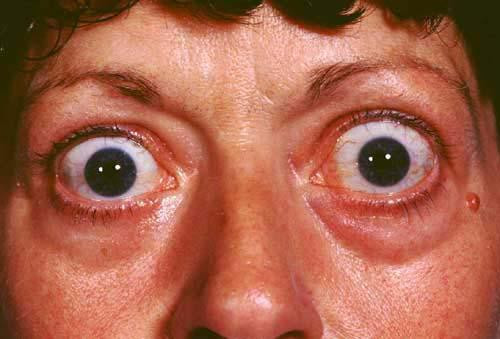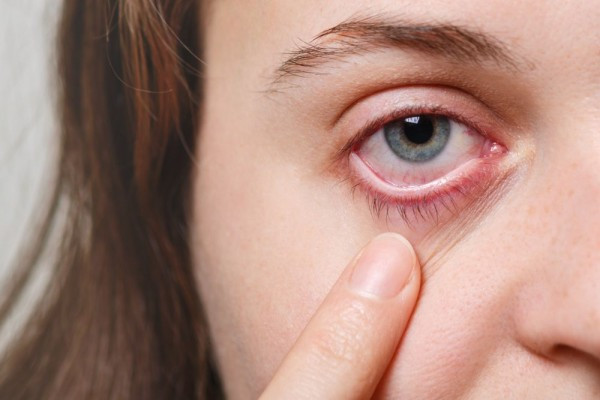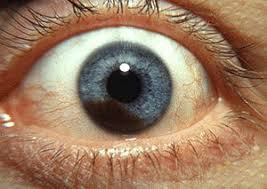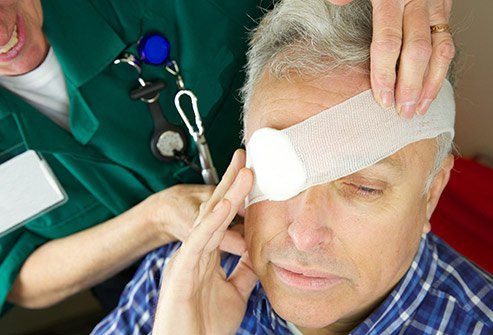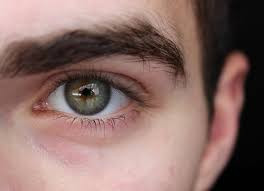Definisi
Retraksi kelopak mata merupakan kondisi di mana tertariknya kelopak mata. Pada retraksi kelopak mata, kelopak mata atas akan tertarik lebih ke atas, sementara kelopak mata bawah akan tertarik lebih ke bawah. Retraksi ini dapat terjadi pada salah satu kelopak saja, atau terjadi hanya pada salah satu mata saja.
Penyebab
Penyebab retraksi kelopak mata bermacam-macam, namun yang tersering adalah cedera pada kelopak mata dan riwayat pembedahan pada kelopak mata. Cedera dan pembedahan dapat menyebabkan peradangan pada otot kelopak mata yang terjadi secara kronik (lama) sehingga otot dapat memendek atau berkontraksi terus menerus hingga menyebabkan kontraktur (kaku). Selain itu, pembedahan dan cedera dapat menyebabkan pemendekan jaringan antara kulit dan konjungtiva (selaput bening yang melapisi bagian putih bola mata dan bagian dalam kelopak mata).
Selain karena pembedahan dan cedera, retraksi kelopak mata dapat pula disebabkan oleh penyakit terkait saraf dan otot. Salah satu penyakit yang terkait dengan kondisi ini adalah penyakit Graves. Pada penyakit Graves, terdapat sistem kekebalan tubuh yang menyerang otot-otot di sekitar bola mata dan kelopak mata, sehingga menyebabkan terjadinya peradangan. Selain itu, kondisi lainnya yang terkait dengan retraksi kelopak mata adalah kelemahan kelopak mata yang disebabkan oleh gangguan pada saraf. Gangguan pada saraf ini dapat terjadi di bagian belakang otak tengah (tanda Colliers) atau pada saraf wajah seperti pada Bell’s palsy.
Penyebab retraksi kelopak mata lainnya dapat terkait dengan kelainan bentuk bola mata, misalnya bola mata yang terlalu panjang sehingga menyebabkan rabun jauh (miopia). Retraksi kelopak mata juga dapat terjadi sebagai bawaan lahir. Masalah pada kulit seperti dermatitis juga dapat menyebabkan retraksi kelopak mata akibat peradangan pada kulit yang terjadi dalam jangka waktu lama. Infeksi pada mata seperti trakoma, yang disebabkan oleh bakteri Chlamydia trachomatis, dapat merusak jaringan pada kelopak mata.
Faktor Risiko
Faktor risiko retraksi kelopak mata terkait dengan kerusakan kulit. Riwayat atopi (alergi) seperti dermatitis atopi (kelainan kulit) dapat meningkatkan risiko terjadinya retraksi kelopak mata. Peradangan pada kulit seperti rosasea (kemerahan pada wajah yang disertai dengan bintik mirip jerawat) dapat pula terjadi pada kelopak mata. Kondisi ini dapat disebabkan oleh paparan sinar ultraviolet yang berlebihan, stres emosional, cuaca yang terlalu panas atau dingin, makanan pedas, konsumsi alkohol, dan sebagainya.
Gejala
Gejala utama retraksi kelopak mata adalah ketidakmampuan mata menutup sempurna. Tanda lainnya dapat menjadi petunjuk penyebab retraksi kelopak mata seperti kemerahan pada wajah disertai bintik mirip jerawat, pembengkakan pada kelopak mata, kulit bersisik kering, mata merah, serta tanda akibat cedera atau operasi seperti bekas luka.
Diagnosis
Retraksi kelopak mata merupakan gejala yang dapat dilihat dengan kasat mata, sehingga pemeriksaan perlu dilakukan untuk mengetahui penyebab retraksi serta komplikasi dari retraksi tersebut. Dokter akan bertanya mengenai riwayat kejadian retraksi kelopak mata, apakah baru terjadi atau sudah lama, riwayat infeksi pada mata seperti mata merah atau kelopak mata bengkak, riwayat atopi (alergi) seperti eksim pada masa kecil, serta riwayat cedera, baik cedera akibat benda tumpul, tajam, atau kimia. Riwayat pembedahan, kanker pada kulit, paparan sinar matahari berlebih, serta reaksi alegi terhadap obat-obatan tertentu juga dapat ditanyakan.
Dokter dapat pula melakukan pemeriksaan langsung kelopak mata untuk mengetahui kelopak mata mana yang mengalami retraksi, serta adanya bekas luka, pembengkakan, penebalan, serta sisik kering pada kelopak mata. Tanda lainnya pada kulit wajah dapat menjadi penanda penyebab retraksi kelopak mata. Anda akan diminta untuk menutup kelopak mata serapat mungkin untuk menguji kekuatan otot kelopak mata.
Pemeriksaan penunjang laboratorium dapat dilakukan jika dokter mencurigai suatu penyebab. Jika curiga ada infeksi, dokter dapat melakukan pemeriksaan usap pada tepi kelopak mata, dekat bulu mata. Hasil usap itu kemudian dapat dilihat di bawah mikroskop atau dibiakkan untuk menemukan penyebab infeksi. Jika dokter mencurigai adanya tumor pada kelopak mata, dokter dapat mengambil jaringan tumor untuk diperiksakan lebih lanjut. Sementara itu, jika diduga ada penyakit Graves, dokter dapat memeriksakan kadar TSH (thyroid stimulating hormone) serta antibodi TSHR (TSH receptor).
Tata Laksana
Tata laksana retraksi kelopak mata sangat tergantung dari durasi penyakit dan penyebabnya. Jika retraksi kelopak mata baru saja terjadi akibat luka bakar kimia atau panas, mengaliri mata dengan air bersih atau cairan infus dapat dilakukan untuk menetralkan zat kimia atau suhu. Sementara itu, apabila dermatitis (eksim) menjadi penyebab retraksi, pemicu dermatitis harus dihindari. Jika terdapat reaksi obat yang sangat parah seperti Sindroma Stevens-Johnson (SSJ), obat penyebab harus segera dicari dan dihentikan. Jika infeksi menjadi faktor yang dicurigai, pemberian antibiotik dapat dilakukan untuk menghentikan infeksi.
Apabila retraksi kelopak mata disebabkan oleh dermatitis, dokter dapat memberikan salep steroid untuk meringankan peradangan pada kulit. Salep steroid ini hanya boleh diresepkan oleh dokter, karena terdapat berbagai macam salep dengan kekuatan dan fungsi yang berbeda, serta pemakaiannya harus diawasi agar tidak menyebabkan efek samping. Jika retraksi kelopak mata berkaitan dengan rosasea, dokter dapat memberikan antibiotik.
Jika dicurigai retraksi kelopak mata terjadi akibat penyakit autoimun, dokter dapat merujuk Anda ke ahli reumatologi. Sementara itu, jika retraksi kelopak mata dicurigai akibat adanya tumor, Anda dapat dirujuk ke ahli onkologi (kanker).
Apabila retraksi kelopak mata terjadi akibat penyakit Graves, dokter dapat memberikan obat-obatan yang bertujuan untuk menurunkan reaksi dari penyakit tersebut. Dokter juga dapat menyuntikkan botox (botulinum toxin) untuk melemaskan otot kelopak mata.
Pembedahan dapat dilakukan dengan berbagai pertimbangan, misalnya terkait posisi retraksi, efektivitas terapi seperti penyuntikan botox, lama retraksi, serta pilihan pasien untuk menjalani pembedahan yang lebih invasif atau minimal invasif.
Komplikasi
Komplikasi retraksi kelopak mata dapat terjadi akibat kondisi itu sendiri atau akibat terapi yang diberikan. Retraksi kelopak mata dapat menyebabkan mata sulit tertutup sempurna sehingga mata lebih mudah kering dan terluka akibat tergores benda asing. Kondisi ini juga dapat menyebabkan mata berair. Selain itu, komplikasi lainnya dapat berupa trikiasis, yaitu kondisi ketika bulu mata tumbuh ke arah dalam mata. Sementara itu, komplikasi akibat terapi dapat berupa glaukoma atau katarak akibat penggunaan steroid, atau koreksi dengan pembedahan yang berlebihan atau kurang.
Pencegahan
Retraksi kelopak mata akibat cedera dapat dicegah. Cedera akibat benda tumpul, tajam, atau kimia dapat dicegah dengan penggunaan pelindung mata saat melakukan pekerjaan berisiko, seperti pekerjaan yang melibatkan pemotongan kayu dan logam. Retraksi kelopak mata akibat rosasea dan dermatitis dapat dicegah dengan menghindari pencetus seperti menggunakan kacamata hitam saat berkegiatan di bawah sinar matahari terik dan menghindari alergen (agen penyebab alergi).
Kapan Harus ke Dokter?
Segeralah ke dokter jika Anda menyadari bahwa kelopak mata Anda tidak dapat menutup sempurna. Kelopak mata yang tidak dapat menutup sempurna secara tiba-tiba, dapat menjadi tanda suatu peradangan akut. Sementara itu, jika keluhan berlangsung lama, dapat menyebabkan keluhan lainnya seperti mata merah dan kering. Kelopak mata memiliki fungsi utama untuk melindungi bola mata dan memastikan mata tetap lembap, sehingga jika tidak ditangani, dapat terjadi komplikasi terkait hal tersebut.
Mau tahu informasi seputar penyakit lainnya? Cek di sini, ya!
- dr Nadia Opmalina
Fox, T., & Anastasopoulou, C. (2021). Graves Orbitopathy. Retrieved 28 November 2021, from https://www.ncbi.nlm.nih.gov/books/NBK549889/
Fu, L., & Patel, B. (2021). Lagophthalmos. Retrieved 28 November 2021, from https://www.ncbi.nlm.nih.gov/books/NBK560661/
Nelson, E. (2021). Eyelid Retraction - American Academy of Ophthalmology. Retrieved 28 November 2021, from https://www.aao.org/oculoplastics-center/eyelid-retraction


